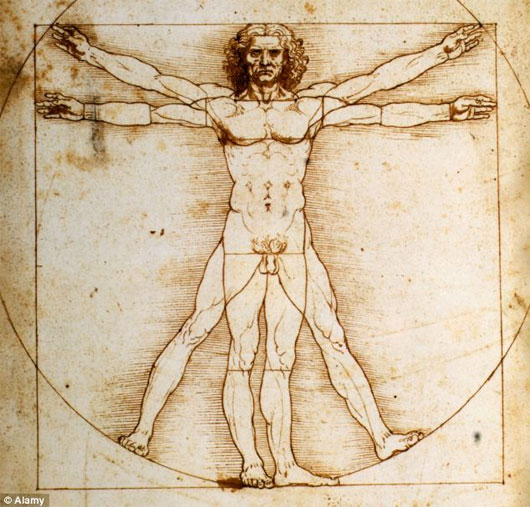Discover Da Vinci's 'Vitruvius' is perfect
The painting 'Vitruvius' , dating from 1490 of the famous Leonardo da Vinci, is one of the best examples of perfect people. However, a new study revealed, Vitruvius may eventually be just a normal person with a disease that could have claimed his life.
The 'Vitruvius Man' depicts a naked man in two different states - straightening his legs and legs in a circular shape and symmetrical square. The man's measurements followed a ratio conceived by da Vinci and recorded below the figure, based on the content of an article 1,500 years ago by the ancient Roman architect Vitruvius.

The 'Vitruvius Person' with a slight bulge above the left side of the groin.(Photo: Alamy)
The artist da Vinci said that people are miniature representatives of the universe and that the picture 'Vitruvius' has shown that.
Many consider the Vitruvius Man prototype to be a perfect gentleman. However, Hutan Ashrafian researcher from Imperial College London (UK) believes that this man is actually suffering from a serious disease.
According to Ashrafian, when studying the painting, we can observe a slight bulge above the left side of the Vitruvius Person's groin. This corresponds to the classic expression of inguinal hernia .
The researcher said doctors knew about inguinal hernias at the time of the painting.
"Knowledge of inguinal hernias is already in the renaissance. Many doctors and surgeons like Antonio Benivieni have described many types of hernias in Florence (Italy) at that time. So," he wrote . The Vitruvius people can be built from the prototype that a person is alive or the body of an individual who has suffered harmless inguinal hernia or who died of disease complications leading to strangulation in the injured area. "
However, Ashrafian's findings are controversial. Some other experts are still skeptical, whether the slight bulge above the left side of the Vitruvius' groin in da Vinci's paintings really implies an inguinal hernia.
- Leonardo da Vinci 'religion' buddy paintings?
- Whether or not the perfect man like Ha Di Tham?
- The photos startle you because of the perfect fit
- The mystery behind the perfect smile
- Scientists discover perfect sex secrets
- Revealing the 'gold' indicator of the perfect nose
- Finding the standard for perfect lips is the most desirable by many people
- Women only like to work 36 minutes a day
- 20 perfect photos without photoshop
- This is the most perfect 'body' for mankind to exist, but it looks freakishly creepy
- The sun is not the perfect sphere
- Want to sleep well, go to bed at 10 pm
 'Fine laughs' - Scary and painful torture in ancient times
'Fine laughs' - Scary and painful torture in ancient times The sequence of numbers 142857 of the Egyptian pyramids is known as the strangest number in the world - Why?
The sequence of numbers 142857 of the Egyptian pyramids is known as the strangest number in the world - Why? History of the iron
History of the iron What is alum?
What is alum?